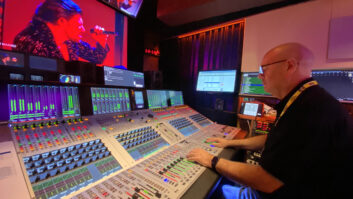ESPN reached a major milestone with its recent coverage of the Winter X Games by shunting the entire programme production workflow over to tapeless. Utilising EVS IP Directors furnished by Bexel Broadcast Services, all live, studio and web coverage was tape-free. Previously, ESPN had utilised a traditional tape-based workflow: recording line feeds and dubbing highlights of each event, relaying them back to the broadcast centre, and hand-carrying tapes to the edit suite – requiring editors to wait until each event concluded and then shuttling through a stack of tapes, writes Fergal Ringrose
Beginning late in 2006, Bexel, ESPN and EVS began exploring how they could transition this year’s event to a tapeless workflow. Recording camera and programme ISOs to tape, logging each feed, and managing tapes across fifteen venues was a difficult task that ESPN’s Operations and Technical Management teams had mastered over years of producing the X Games. With venue acquisition already taking place on EVS disk recorders, a Bexel team headed by lead engineer Greg Blanton devised an integrated system for ESPN that met this project’s complex challenges.
Eleven EVS XT disk recorders, located in three NEP venue production trucks (ND-2, SS-12 and SS-16), comprised a 60-channel server network. Two EVS IP Director logging stations created searchable logs and content metadata that both the venue and broadcast centres could access and use, and two additional IP Directors allowed direct searching and access to venue content. Three EVS XFile archive devices transferred the logged content to ESPN’s broadcast centre operation and returned finished feature packages back to the venue trucks for live production.
Eleven additional disk recorders, XT[2] models in this case, were onboard NEP’s SS-25 truck, which also serves ESPN Monday Night Football. These were utilised to create a 46-channel broadcast centre production server. Fourteen IP Directors enabled producers to search the venue logs, clips and individual event programme ISOs, as well as manage melts, Avid ingest, linear editing, media conversion and associated duties. Two XFiles managed content from the 9.2TB storage array, and EVS’ MediaXChange handled EVS-to-AVI format conversions.
Two EVS SQL servers provided database management and constant backup throughout the event. This server-based, tapeless workflow provided instant access to a manageable set of digital assets for every X Games production group. And nearly everyone benefited as a result: producers didn’t have to spend hours searching through tapes for “that one great shot” any more, because they had immediate access to the entire array of camera angles; editors didn’t have to wait hours for “the tapes” to arrive any more, because they had immediate access to the footage needed to finish their feature packages; and broadcast and Sports Center production crews didn’t have to record their own feeds for air any more, because all venue content was immediately available for their respective shows on demand.
ESPN 360 subscribers were able to view X Game features online even sooner, because all content was immediately available for fast formatting and delivery over the internet. And even ESPN’s accountants were pleased, because the cost of tape stock was almost entirely eliminated!







